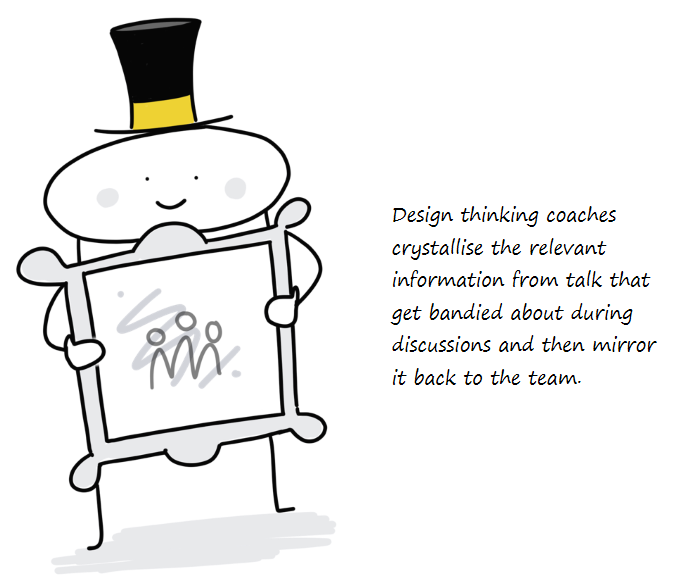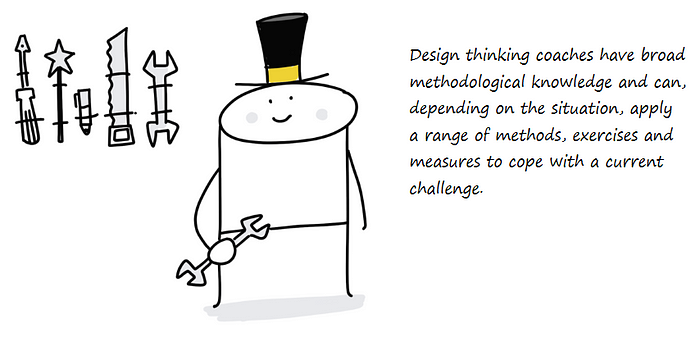What are the Most Important Qualities & Capabilities of Design Thinking Coaches?
The many facets of design thinking and its diverse application scenarios pose special challenges for those who support and facilitate such projects and processes. Design-related literature has only recently focused on the role of facilitators with regards to increasing productivity (see Liedtka, 2018). Admittedly, team coaching in general is not a new topic in the literature (c.f. Hackman & Wageman, 2005; Clutterbuck, 2007; Thornton, 2010; Hawkins, 2011; Peters & Carr, 2013 and Jacox, 2016). And yet, we know very little about the requirements for successful DT coaching. It is here that this article contributes. Based on a two-stage Delphi study conducted with eleven design thinking coaches followed by five in depth interviews, I propose five qualities and eleven capabilities that are essential for successfully guiding people through a design thinking learning journey. Here, a quality is a distinguishable characteristic of a person. A capability, in turn, is an ability acquired through training and experience.¹
The following briefly discusses all five qualities and eleven capabilities with a short description below. The link to the full paper (so far only in German) can be found in the references.
Qualities
1)

Metaphorically speaking, the coach is like a conductor of an orchestra. Like a conductor, the coach recognizes individual qualities, moods and roles and then addresses, highlights, promotes or restrains members strategically, according what the team needs. To do this, coaches need to be very perceptive and aware.
2)

Working with teams means having to deal with different people. Appreciating this diversity as well as approaching each person openly and respectfully is an important basic attitude. It successfully supports individuals and lets productive team work evolve. Additionally, it is equally important to deal with oneself, as this attitude is transferred to others.
3)

Reflection is the key to learning and, therefore, is essential when coaching teams. Reflection entails coaches consciously thinking about their experiences as well as about the signals they send to those around them. What is more, reflection then also implies questioning what the experiences may mean and how their actions affect others. Thereby it is important for coaches to also draw on external perspectives by eliciting feedback from other actors in the process.
4)

Good coaches help teams by sharing their knowledge and experiences. However, coaches need to be careful not to unduly influence the team. Therefore it is important for coaches to deploy their knowledge skillfully and at the right time.
5)

The appearance of coaches and their performance shapes peoples’ learning experience. As a result, authenticity transports important aspects of design thinking. Therefore coaches should be aware of their position as role models: they need to apply as well as exemplify the basic principles of design thinking.
Capabilities
1)

The essence of design thinking lies less in the application of specific methods than in the implementation of certain ways of thinking and working. While methods can help teams pursue this aim, they are, ultimately, no more than tools. Coaches should be aware of these underlying goals in order to effectively support teams. This holds true both when it comes to applying methods as well as when considering the role of design thinking in innovation projects.
2)

By their very nature, innovation processes bring about a great deal of uncertainty. This means that it is important for coaches facilitating these processes to be flexible so that they can adequately respond to changing circumstances at all times. Here, intuition plays a significant role because there is only so much coaches can plan. Unexpected incidents occur again and again — dealing with them means taking decisions based on an intuitive reading of situations.
3)

Due to their experience and know-how, design thinking coaches are the experts of the design thinking process. It is important that coaches use this knowledge to support the team in situations in which team members are unaware of the implications of their decisions later in the process. At the same time, this ability also helps teams to express and structure their ideas and thoughts.
4)

The interviews revealed that coaches can take on one of five different roles: the coach as a neutral process facilitator guiding the team through the process, the coach as a teacher, the coach as a consultant, the coach as a motivator and the coach as a team member or ‘creative leader’. When coaching, it is important to recognize which role is most needed and when it is likely to have a positive effect. Here you will not get a clear answer; rather, coaches develop sensitivity for these roles through experience.
5)

Convergent and divergent thinking — both conscious and unconscious — feature prominently in design thinking processes. Divergent thinking is about generating a wide range of possibilities by exploring many potential alternatives. Convergent thinking, in turn, is about the evaluation of alternatives and making decisions. As a coach, it is important to know when to activate these different modes of thinking and to guide the team in applying the right mode at the right time.
6)

Although the design thinking process is dynamic and iterative it still follows a structure of sequential working stages. It is important for coaches to know exactly where a team is in the process and what this implies in terms of objectives, tasks and activities. Moreover, good coaches recognize when a team is ready to move along in the process. However, each team will experience the DT process differently both in terms of team dynamics as well as in terms of the actual design challenge. Here, extensive experience, including experimentation with methods and tools, will help coaches deal with the wide variety of different situations.
7)

There are various measures that motivate teams to explore the new and unknown. In interviews, respondents repeatedly pointed to passion and enthusiasm as important factors for promoting emotional learning. Yet, there is no standard approach that can always be counted on to work. Rather, since individuals will react differently to different approaches, coaches need to develop a wide repertoire of motivational methods.
8)

Design thinking draws on different methods and exercises from different disciplines, such as the social sciences, design research or improvisation theater. Therefore, good coaches have a broad knowledge base, experiment with a variety of approaches, and look for inspirations from different fields. Ultimately, being able to adapt and tweak a basic repertoire of methods is more important than knowing hundreds of methods off by heart.
9)

This ability combines empathy, openness and experience. Good coaches recognize, accept and work with different roles in the team. They can also discern imbalanced or unequal social relationships and deal with them accordingly. Particularly with regard to existing hierarchies, coaches may take on a regulating role to consciously balance possible inequities or dysfunctional patterns of behavior.
10)

On the one hand, this ability describes a responsible and professional use of language. On the other hand, it is also about finding the right way to communicate effectively with any particular team. This capability should be developed continuously.
11)

The physical space is an important tool for supporting teams and for implementing the principles of design thinking. Design thinking coaches should be experts for creating an awareness of space by targeted interventions. Spatial measures are divided into the macro level of setting up whole spaces for innovation projects and the micro level of continuously rearranging team spaces as the need arises.
Summary
To summarize: Design thinking coaches are empathic, appreciative and self-reflective. They have a deep understanding of the core principles and mindsets of design thinking. Good design thinking coaches are able to flexibly and intuitively apply the right measures at the right time to support the work and learning process of design teams. Ultimately, here is an overview of the most important qualities and capabilities of design thinking coaches:

Thank you for reading this, I hope this is helpful for you. More in-depth reflections regarding the results of the study will follow. I believe the discussion of coaching in design thinking is crucial to maintain quality and drive design thinking forward. As the results of the study indicate that DT coaching has a lot of similarities with team coaching in general, especially regarding the qualities of a coach, prior contributions to team coaching should be part of that discussion as well. Let me know what you think: feedback and additional thoughts are always appreciated. And, last but not least: Thank you so much to the wonderful Mana Taheri for the visualizations!
Footnotes:
¹ Yet, it is likely that through intensive training and experience, capabilities can also become a quality of a person.
Illustrations:
Illustrations by Mana Taheri: hello@manataheri.com
References:
Clutterbuck, D., 2007. Coaching the team at work. London, England: Nicholas Brealey.
Hackman, J.R., & Wageman, R., 2005. A theory of team coaching. Academy of Management Review, 30(2), 269−287.
Hawkins, P., 2011. Leadership team coaching. London, England: Kogan Page.
Jacox, W., 2016. What Are the Key Qualities and Skills of Effective Team Coaches? Antioch University: Dissertations & Theses. 267.
Liedtka, J., 2018. Exploring the Impact of Design Thinking in Action. Darden Working Paper Series.
Peters, J., & Carr, C., 2013. High performance team coaching: A comprehensive system for leaders and coaches. Victoria, British Columbia: Friesen Press.
Tschepe, S., 2017. Was sind die wichtigsten Eigenschaften und Fähigkeiten von Design Thinking-Coaches? Available at: http://www.designthinkingundcoaching.de [Accessed 1 October 2018].

